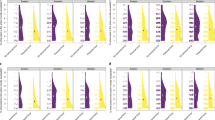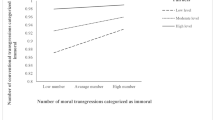Abstract
The construct of moral intensity, proposed by Jones (1991), was used to predict the extent to which individuals were able to recognize moral issues. We tested for the effects of the six dimensions of moral intensity: social consensus, proximity, concentration of effect, probability of effect, temporal immediacy and magnitude of consequences. A scenario-based study, conducted among business individuals in Singapore, revealed that social consensus and magnitude of consequences influenced the recognition of moral issues. The study provided evidence for the effects of temporal immediacy. There was marginal support for the impact of proximity and probability of effect but no evidence that concentration of effect influenced recognition of moral issues. The paper concludes with a discussion of the implications of these results for researchers and organisational practitioners.
Similar content being viewed by others
References
Alexander, C. S. and H. J. Becker: 1978, ‘The Use of Vignettes in Survey Research’, Public Opinion Quarterly 42(1), 93–104.
Ballard, R.: 1992, ‘Short Forms of the Marlowe-Crowne Social Desirability Scale’, Psychological Reports 72, 1155–1160.
Barry, V.: 1979, Moral Issues in Business(Wadsworth, Belmont, California).
Baumhart, R. C.: 1961, ‘How Ethical are Businessmen?’, Harvard Business Review 39 ( July–August), 6–19, 156–176.
Beauchamp, T. L. and N. E. Bowie: 1979, Ethical Theory and Business(Prentice Hall, Englewood Cliffs, NJ).
Bird, F. and J. Gandz: 1991, Good Management: Business Ethics in Action(Prentice-Hall Canada, Scarborough, Ontario).
Brenner, S. N. and E. A. Molander: 1977, ‘Is the Ethics of Business Changing?’, Harvard Business Review 55(1), 57–71.
Cohen, J.: 1992, ‘A Power Primer’, Psychological Bulletin 112(1), 155–159.
Crowne, D. P. and D. Marlowe: 1964, The Approval Motive(Wiley, New York).
Dubinsky, A. J. and B. Loken: 1989, ‘Analyzing Ethical Decision Making in Marketing’, Journal of Business Research 19(2), 83–107.
Fritzsche, D. J.: 1988, ‘An Examination of Marketing Ethics: Role of the Decision-Maker, Consequences of the Decision, Management Position, and Sex of the Respondent’, Journal of Macromarketing 8(2), 29–39.
Fritzsche, D. J. and H. Becker: 1983, ‘Ethical Behaviour of Marketing Managers’, Journal of Business Ethics 2, 291–299.
Fritzsche, D. J. and H. Becker: 1984, ‘Linking Management Behaviour to Ethical Philosophy: An Empirical Investigation’, Academy of Management Journal 27(1), 166–175.
Hembroff, L. A.: 1987, ‘The Seriousness of Acts and Social Contexts: A Test of Black's Theory of the Behaviour of Law’, American Journal of Sociology 93(2), 322–347.
Hosmer, L. T.: 1991, The Ethics of Management, 2nd ed. (Irwin, Illinois).
Hunt, S. D. and S. Vitell: 1986, ‘A General Theory of Marketing Ethics’, Journal of Macromarketing 6(1), 5–16.
Jones, T. M.: 1991, ‘Ethical Decision Making by Individuals in Organisations: An Issue-Contingent Model’, Academy of Management Review 16(2), 366–395.
Kahneman, D. and A. Tversky: 1973, ‘On the Psychology of Prediction’, Psychological Review 80, 237–251.
Koehler, J. J.: 1996, ‘The Base Rate Fallacy Reconsidered: Normative, Descriptive and Methodological Challenges’, Behavioural and Brain Sciences 19(1), 1–53.
Laczniak, G. R. and E. J. Inderrieden: 1987, ‘The Influence of Stated Organisational Concern upon Ethical Decision Making’, Journal of Business Ethics 6, 297–307.
March, J. and Z. Shapiro: 1987, ‘Managerial Perspectives on Risk and Risk Taking’, Management Science 33(11), 1404–1408.
Marshall, B. and P. Dewe: 1997, ‘An Investigation of the Components of Moral Intensity’, Journal of Business Ethics 16, 521–530.
Mattews, M. C.: 1988, Strategic Intervention in Organisations: Resolving Ethical Dilemmas(California Sage, Newbury Park).
Milgram, S.: 1974, Obedience to Authority(Harper & Row, New York).
Morris, S. A. and R. A. McDonald: 1995, ‘The Role of Moral Intensity in Moral Judgments: An Empirical Investigation’, Journal of Business Ethics 14, 715–726.
Rest, J. R.: 1986, Moral Development: Advances in Research & Theory(Praeger, New York).
Robertson, D. C. and E. Anderson: 1993, ‘Control System and Task Environment Effects on Ethical Judgment: An Exploratory Study of Industrial Salespeople’, Organization Science 4(4), 617–644.
Shelley, Majorie K.: 1994 ‘Gain/Loss Asymmetry in Risky Intertemporal Choice’, Organizational Behaviour and Human Decision Processes 59, 124–159.
Singhapakdi, A., S. Vittel and K. L. Kraft: 1996, ‘Moral Intensity and Ethical Decision-Making of Marketing Professionals’, Journal of Business Research 36, 245–255.
Thompson, W. C. and E. L. Schumann: 1987, ‘Interpretation of Statistical Evidence in Criminal Trials: The Prosecutor's Fallacy and the Defence Attorney's Fallacy’, Law and Human Behaviour 11(3), 167–187.
Trevino, L. K.: 1986, ‘Ethical Decision Making in Organizations: A Person-Situation Interactionist Model’, Academy of Management Review 11(3), 601–617.
Waters, J. A., F. Bird and P. D. Chant: 1986, ‘Everyday Moral Issues Experienced by Managers’, Journal of Business Ethics 5, 373–384.
Wells, G. L.: 1992, ‘Naked Statistical Evidence of Liability: Is Subjective Probability Enough?’, Journal of Personality and Social Psychology 62(5), 739–752.
York, K. M.: 1989, ‘Defining Sexual Harassment in Workplaces: A Policy-Capturing Approach’, Academy of Management Journal 32, 830–850.
Author information
Authors and Affiliations
Rights and permissions
About this article
Cite this article
Chia, A., Lim, S.M. The Effects of Issue Characteristics on the Recognition of Moral Issues. Journal of Business Ethics 27, 255–269 (2000). https://doi.org/10.1023/A:1006392608396
Issue Date:
DOI: https://doi.org/10.1023/A:1006392608396




